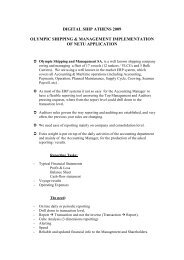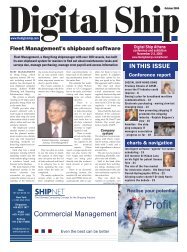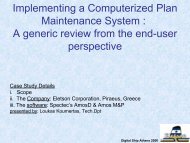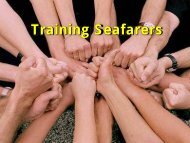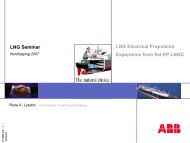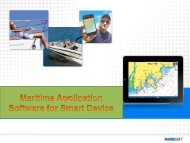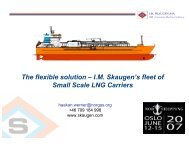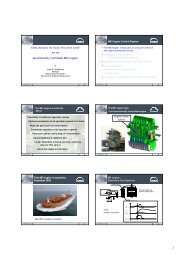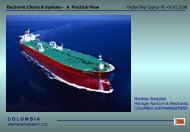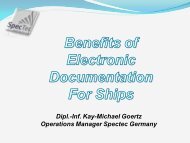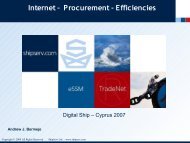Torm Shipping chooses VSAT for entire fleet - Digital Ship
Torm Shipping chooses VSAT for entire fleet - Digital Ship
Torm Shipping chooses VSAT for entire fleet - Digital Ship
Create successful ePaper yourself
Turn your PDF publications into a flip-book with our unique Google optimized e-Paper software.
ELECTRONICS & NAVIGATION<br />
Balancing technology and integrity<br />
T<br />
Improved technology can reduce the number of errors in navigational accuracy - but does it also reduce awareness<br />
that the potential <strong>for</strong> errors still exists? Dr Andy Norris looks at the issue of navigational integrity<br />
he phrase integrity monitoring is<br />
increasingly used in the navigation<br />
world. It has been commonly<br />
applied to processes within advanced electronic<br />
navigational equipment but is now<br />
being used to describe essential aspects of<br />
the human involvement in navigation.<br />
Integrity monitoring within equipment<br />
alerts the user if the navigational accuracy<br />
has become suspect, and that the system<br />
should be used with caution or not at all.<br />
For instance, IMO requires all GPS<br />
units to have Receiver Autonomous<br />
Integrity Monitoring (RAIM) to immediately<br />
detect and in<strong>for</strong>m the user if the<br />
positional accuracy has been compromised<br />
by a signal from a faulty satellite.<br />
Also, Integrated Navigation Systems<br />
(INS) con<strong>for</strong>ming to IMO requirements<br />
monitor integrity by evaluating inputs<br />
from several sources and giving timely<br />
alerts if a problem is detected.<br />
In the past, when navigation was a<br />
mainly manual task, mistakes were easy to<br />
make and were there<strong>for</strong>e common, constantly<br />
reminding the mariner of the need<br />
<strong>for</strong> validation of all navigational processes.<br />
Today, because of the increased use of<br />
electronics, navigational errors have significantly<br />
reduced to a point on many<br />
ships where there is no regular reminder<br />
that things can go wrong.<br />
The increasing reliability and effectiveness<br />
of equipment tends to give a false<br />
sense of security. However, we are a long<br />
way from ship's navigation equipment<br />
being able to be considered as intrinsically<br />
reliable.<br />
Because the human is becoming far less<br />
involved with the detailed process of<br />
establishing the navigation solution, it<br />
perhaps becomes too easy to accept what<br />
is seen on a display. As ECDIS replaces the<br />
use of paper charts, this becomes an even<br />
greater problem.<br />
It is there<strong>for</strong>e essential that the OOW<br />
continues to maintain a constant check on<br />
the integrity of the displayed navigational<br />
situation.<br />
Manual checking<br />
Manual checking of integrity firmly links<br />
the user into the navigation process and<br />
exposes problems be<strong>for</strong>e a failure leads to<br />
a dangerous situation.<br />
Integrity checking is not just a matter of<br />
confirming position. It also needs to cover<br />
all navigational data, including own ship's<br />
speed, heading and course, the movement<br />
and current position of other vessels significant<br />
to navigation, and the proximity<br />
of charted features and hazards.<br />
Establishing integrity is all about checking<br />
the perceived navigational situation<br />
with reality. Fundamentally, there<strong>for</strong>e, it<br />
acts to significantly improve overall<br />
awareness.<br />
Although manual integrity checking is<br />
based on establishing whether there is a<br />
fault in any equipment or system, its spinoff<br />
benefit in improving situational awareness<br />
is of even higher significance, simply<br />
because most collisions and groundings<br />
are caused by inadequate situational<br />
awareness.<br />
Positional integrity can be enhanced in<br />
coastal waters by taking visual bearings<br />
on conspicuous charted objects, transferring<br />
the bearings to the chart and checking<br />
that appropriate tie-up has been obtained.<br />
It is essential to manually check the integrity<br />
of data from navigational technology<br />
Traditional three point fixes can be<br />
taken but frequent single bearings can be<br />
even more useful in many circumstances,<br />
especially on ECDIS. The latency can be<br />
very short and there<strong>for</strong>e even relatively<br />
small errors in the electronically derived<br />
position can become apparent from a good<br />
visual fix.<br />
Transferring radar conspicuous ground<br />
fixed objects to the chart, again very easy<br />
to do if using ECDIS, will identify positional<br />
inaccuracies. These could be due to<br />
problems in the positioning system, the<br />
radar or the gyro. The most likely error<br />
source is easy to determine from a series of<br />
measurements if an initial discrepancy is<br />
found.<br />
The echo sounder output should also<br />
be used as a consistency check with charted<br />
data. Differences may indicate positional<br />
problems, faulty equipment, an<br />
inaccurate chart or a failure to compensate<br />
properly <strong>for</strong> tidal difference.<br />
For ocean waters, the options <strong>for</strong> monitoring<br />
positional integrity have been quite<br />
limited. However, a reasonably effective<br />
method is to compare the current GPS<br />
position with an estimated position based<br />
on the GPS position of an earlier time.<br />
It is necessary to include leeway, tidal<br />
streams, ocean currents and surface drift<br />
but the act of determining these adds<br />
greatly to situational awareness.<br />
Of course, the accuracy of such an estimated<br />
position will not match that of GPS<br />
<strong>Digital</strong> <strong>Ship</strong> <strong>Ship</strong> December 2008 page 30<br />
but it will indicate gross errors and alert<br />
the bridge team to the take appropriate<br />
cautionary actions.<br />
Celestial positioning is also a possibility<br />
<strong>for</strong> those wanting to show off their skills<br />
but in many areas of the world the poor<br />
availability of sights makes this a very<br />
unreliable method <strong>for</strong> regular verification<br />
of GPS position.<br />
GLONASS<br />
Greatly improved positional integrity<br />
monitoring of both ocean and coastal<br />
route segments is possible using the<br />
GLONASS satellite navigation system. It<br />
now has 17 operational satellites, giving<br />
good accuracy over a considerable proportion<br />
of the globe.<br />
The present coverage is certainly good<br />
enough to justify fitting it to SOLAS vessels<br />
as a position sensor independent of<br />
GPS. Over half of the present satellites<br />
have been launched since the beginning of<br />
2007 and the expectation is that truly global<br />
coverage is achievable in relatively<br />
short timescales.<br />
Fitted equipment should be certified to<br />
meet IMO standards but these may be difficult<br />
to procure at present. Non-approved<br />
systems may interfere with other bridge<br />
navigational equipment and may not meet<br />
all IMO requirements.<br />
Ideally, there should be an automatic<br />
integrity monitoring process continuously<br />
comparing the GPS and GLONASS positions<br />
and generating an alert if the position<br />
differs by more than a user-set<br />
amount.<br />
Despite automatic checks, the OOW<br />
should still per<strong>for</strong>m manual integrity<br />
checks on the actual difference and, in<br />
coastal and harbour waters, continue to<br />
check position visually and with radar,<br />
particularly to gain the benefits of<br />
increased situational awareness.<br />
By the middle of the next decade GPS<br />
and GLONASS will be joined by other<br />
satellite navigation systems, such as<br />
Europe's Galileo and China's Compass.<br />
It is also possible that eLoran will be in<br />
use in some coastal areas by then. It has<br />
the advantage that its failure mechanisms<br />
are very different to that of satellite systems,<br />
further increasing the quality of<br />
integrity monitoring.<br />
Detection of other<br />
vessels<br />
Comparison of visual, radar and AIS data<br />
should be made on all vessels that are, or<br />
may become, significant to navigation.<br />
Consistency in all three methods gives<br />
great confidence in the integrity of the<br />
in<strong>for</strong>mation concerning that target.<br />
Differences should ring mental alarm<br />
bells.<br />
Correlation in two out of the three<br />
methods, providing the prevailing circumstances<br />
are consistent with any inaccuracy<br />
or unavailability of the third, should also<br />
give the OOW good confidence in the<br />
integrity of the plot.<br />
However, all three main methods of<br />
detecting vessels and other floating objects<br />
have common problems.<br />
For instance: visual data is easily<br />
impaired in poor conditions; radar data is<br />
considerably affected by sea clutter and<br />
rain; not all vessels have AIS fitted and on<br />
those that do erroneously transmitted data<br />
could affect the perceived position of the<br />
target and create other anomalies.<br />
If there is only one indication of a target<br />
from the three possible sources, great care<br />
is needed in assessing the necessary<br />
required action, as the indication could be<br />
erroneous. However, in general, it is likely<br />
to be valid - almost certainly in many conditions,<br />
if visual - and appropriate avoiding<br />
action should be taken.<br />
Consistently missed radar targets could<br />
indicate a radar equipment fault or that it<br />
is badly set up. If many ships are not<br />
exhibiting AIS data or are wrongly displayed<br />
it is likely to indicate a fault with<br />
own equipment, which should be urgently<br />
checked.<br />
A poor antenna connection is a<br />
common cause of problems with displayed<br />
AIS targets. If so, it is likely to<br />
mean that own-ship's transmissions will<br />
be compromised.<br />
Un<strong>for</strong>tunately, most ships cannot yet<br />
display AIS data on radar, making proper<br />
comparison an unwieldy task. However, a<br />
number of specific checks during a watch<br />
that compare specific AIS targets from the<br />
MKD with radar data are still worthwhile,<br />
at least to check <strong>for</strong> possible ownship<br />
equipment errors.<br />
As technology gradually improves<br />
there is likely to be a time when the navigation<br />
solution does not need to be<br />
checked by the OOW <strong>for</strong> integrity.<br />
However, until we enter an even more<br />
distant point in time when technology<br />
could completely take over, the human<br />
OOW will always need to retain situational<br />
awareness in order to make appropriate<br />
navigational decisions. Continuing to<br />
check integrity is an excellent way of helping<br />
to achieve this.<br />
DS<br />
Dr Andy Norris has been well-known in the maritime navigation industry<br />
<strong>for</strong> a number of years. He has spent much of his time managing high-tech<br />
navigation companies but now he is working on broader issues within the<br />
navigational world, providing both technical and business consultancy to<br />
the industry, governmental bodies and maritime organizations.<br />
Email: apnorris@globalnet.co.uk



